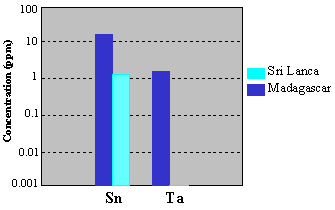| Result Quantitative analysis values of elements such as Na, Mg, K, Ti, V, Cr, Mn, Fe, Ni, Cu, Ga, Nb, Sn and Ta are shown in Table-3. almost the same amount of highly concentrated Ti and Fe were detected in blue sapphires from both Madagascar and Sri Lanka. Ti and Fe in the stones from Madagascar were 0.003%ü`0.012üō and 0.088üōü`0.112%, and in the stones from Sri Lanka were 0.0008üōü`0.017% and 0.018%ü`0.113% respectively. Contented amount of Na, K, Cr or Ga tend to be slightly higher in the stone from Sri Lanka but no significant difference were recognised. Minute amount of heavy elements such as Sn (tin) and Ta (tantalum) were under detection limit in the stones from Sri Lanka, while several to several dozens ppm of those elements were detected in the stones from Madagascar, which posed significant difference between them (Fig-4). Shown in Fig-5 is a "Chemical Finger Print" indicating Cr2O3%ü^Ga2O3% and Fe2O3üōü^TiO2% of blue sapphires from six major countries of the world, with which sapphires from basaltic origin and non-basaltic origin can be clearly differentiated.
Summary Results of the study on origin determination of natural unheated blue sapphire using LA-ICP-MS analysis were shown above. Blue sapphires of non-basaltic origin from Madagascar and from Sri Lanka, which were difficult to be distinguished from each other by traditional methods (such as observation of internal features, spectroscopic analytical method or trace-element analysis by X-ray fluorescence analytical method), showed clear differences. This means that Sn (tin) and Ta (tantalum) from Madagascar were detected in order of ppm, while those two elements were under detection limit in the stones from Sri Lanka. Analysis of trace elements by LA-ICP-MS provide us important information in studying growth environment of a gemstone. We would like to gain more samples to improve the sensitivity of origin determination. |
||||||||||||||||||||||||||||||||||||||||||||||||||||||||||||
|
||||||||||||||||||||||||||||||||||||||||||||||||||||||||||||

